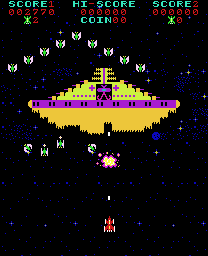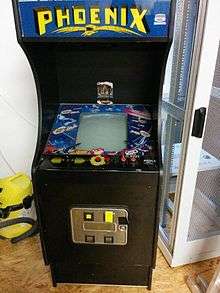Phoenix (video game)
Phoenix is an outer space-themed, fixed shooter video game released in arcades in 1980. According to Centuri's Joel Hochberg, the game was licensed from "a smaller Japanese developer."[1] Amstar Electronics (which was located in Phoenix, Arizona)[2] licensed the game to Centuri for manufacture in the United States. Taito released the game in Japan.[3] Atari, Inc. released a port of Phoenix for the Atari 2600 in 1982.[4]
| Phoenix | |
|---|---|
 | |
| Publisher(s) | Centuri, Taito (Arcade) Atari, Inc. (Atari 2600) |
| Platform(s) | Arcade, Atari 2600 |
| Release | Arcade
|
| Genre(s) | Fixed shooter |
| Mode(s) | 1-2 players alternating |
| Cabinet | Upright, cocktail |
| Display | Vertical raster, standard resolution |
The Phoenix mothership is one of the first video arcade game bosses to be presented as a separate challenge.[5] This was before the term boss was coined.
Gameplay

The player controls a spaceship that moves horizontally at the bottom of the screen, firing upward. Enemies, typically one of two types of birds, appear on the screen above the player's ship, shooting at it and periodically diving towards it in an attempt to crash into it. The ship is equipped with a shield that can be used to zap any of the alien creatures that attempt to crash into it. The player cannot move while the shield is active and must wait approximately five seconds before using it again.
The player starts with three or six lives, depending on the settings. One life is lost whenever the ship is hit by any enemy or projectile while the shield is down.
Each level has five separate rounds. The player must complete a round to advance to the next.
- Rounds 1 and 2 – The player must destroy a formation of alien birds. While in formation, some of the birds fly down kamikaze style, in an attempt to destroy the player's spaceship by crashing into it. Hitting a birdlike enemy flying diagonally awards a bonus score. The birdlike enemies are yellow in round 1, and pink in round 2. The player's spaceship is given rapid fire for round 2, where the birdlike creatures fly somewhat more unpredictably.
- Rounds 3 and 4 – Flying eggs float on the screen and seconds later hatch, revealing larger alien birds, resembling phoenices, which swoop down at the player's spaceship. The only way to fully destroy one of these birdlike creatures is by hitting it in its belly; shooting one of its wings merely destroys that wing, and if both wings are destroyed, they will regenerate. From time to time the birdlike creatures may also revert to the egg form for a brief period. The birdlike creatures are blue in round 3, and pink in round 4.
- Round 5 – The player is pitted against the mothership, which is controlled by an alien creature sitting in its center. To complete this round, the player must create a hole in the conveyor belt-type shield to get a clear shot at the alien. Hitting the alien with a single shot ends the level and scores 400–8,200 points. The mothership fires missiles at the player's ship, moves slowly down towards it, and has alien birds (from rounds 1 and 2) protecting it. Defeating all of the birds will produce a new wave.
The game continues with increasing speed and unpredictability of the birdlike creature and phoenix flights.
Development
Hardware

Phoenix was available in both arcade and cocktail cabinets. A DIP switch setting allows the game to be moved between formats.
Most Phoenix games are in a standard Centuri woodgrain cabinet, but several other cabinets exist, due to this game being sold by multiple companies at the same time. These use sticker sideart (which covers the upper half of the machine), and glass marquees. The control panel is made up entirely of buttons; no joystick is present in the Centuri version, except for the international models and some cocktail versions. The monitor in this machine is mounted vertically, and the monitor bezel is relatively unadorned. Phoenix uses a unique wiring harness, which isn't known to be compatible with any other games.
Circuitry in the Centuri version:
- CPU: 8085 at 5.5 MHz.
- RAM: 4 kB (8 2114 1k x 4 chips.)
- ROM: 16 kB (8 2716 2k x 8 chips.)
- Audio: Matsushita MN6221AA chip, along with discrete circuitry.
- Video: discrete circuitry, utilizing 4 more 2716 2k x 8 EPROMs, as well as 2 256 x 4 bipolar PROMs.[6]
Music
There are two pieces of music featured in the game:
- Romance de Amor also known as Spanish Romance by an unknown composer.
- Für Elise by Beethoven.
Both songs are built directly into the Matsushita MN6221AA Melody IC, as opposed to being programmed into the game's code as is standard in games. In some bootleg versions of the game, which used the namco galaxian Board, House of the rising sun is played at the start of the game.
Bugs
When the player shoots three birdlike enemies in a row very quickly as they fly upwards, the total score is set to a value in the vicinity of 204,000 points.[7]
Reception
Bill Kunkel and Arnie Katz of Electronic Games called Phoenix "perhaps the finest invasion title ever produced for the 2600!", praising its "fantastic graphics, unexcelled play-action and more".[4] The game received a Certificate of Merit in the category of "1984 Best Science Fiction/ Fantasy Videogame" at the 5th annual Arkie Awards.[8]:42
In a retrospective review by Brett Alan Weiss (AllGame) the game was awarded a five out of five rating, referring to it as a "one of the most impressive games the "slide-and-shoot" genre has to offer, bested only by Galaga in terms of sheer enjoyment and replayability" and concluded that "Finely balanced shooting action combined with colorfully animated graphics make Phoenix a true classic among shooters."[9]
Legacy
Re-releases
In 2005, Phoenix was released on the Xbox, PlayStation 2, PSP and Microsoft Windows as part of Taito Legends in the US and Europe, and Taito Memories II Gekan in Japan.
Clones
- Griffon, Videotron in 1980.
- Falcon was released by BGV. in 1980.
- Vautour was released by Jeutel in 1980 in France.
- Condor was released by Sidam in 1981.
- Pheenix was released by Megadodo for the ZX Spectrum in 1983.
- Eagle Empire was released by Alligata for the BBC Micro in 1983. It was also ported to the Commodore 64 in 1984.
- Firebirds was released by Softek for the ZX Spectrum in 1983.
The Imagic game Demon Attack for the Atari 2600 closely resembled Phoenix which Atari owned the 2600 rights to. Atari sued Imagic, who settled out of court.
Bootlegs
- Phoenix was released by T.P.N in 1980.
- Phoenix was released by IRECSA, G.G.I Corp in 1980.
See also
- Golden age of video arcade games
References
- Jon (13 February 2006). "Joel Hochberg (Centuri Inc, Nintendo, Rare Inc) Email Interview". Centuri.net. Retrieved 11 February 2019.
- p. 163, Racing the beam: the Atari Video computer system, by Nick Montfort and Ian Bogost, MIT Press, 2009, ISBN 0-262-01257-X.
- Phoenix at the Killer List of Videogames
- Katz, Arnie; Kunkel, Bill (June 1983). "Programmable Arcade". Electronic Games. pp. 38–42. Retrieved 6 January 2015.
- Sterbakov, Hugh. (2008-03-05) The 47 Most Diabolical Video-Game Villains of All Time. Gamepro. Retrieved on 2008-04-28.
- Phoenix service manual, Centuri, Inc., #364-62-0100 A.
- Hodges, Don (22 January 2018). "Phoenix's Scoring Bug Analyzed and Fixed". Retrieved 7 November 2016.
- Kunkel, Bill; Katz, Arnie (January 1984). "Arcade Alley: The Arcade Awards, Part 1". Video. Reese Communications. 7 (10): 40–42. ISSN 0147-8907.
- Weiss, Brett Alan. "Phoenix". AllGame. Archived from the original on 14 November 2014. Retrieved 14 August 2019.
External links
| Wikimedia Commons has media related to Phoenix (video game). |
- Phoenix at the Killer List of Videogames
- Phoenix at Arcade History
- Phoenix entry at the Centuri.net Arcade Database
- Phoenix for the Atari 2600 at Atari Mania
- Eagle Empire for the BBC Micro and Commodore 64 at Mobygames